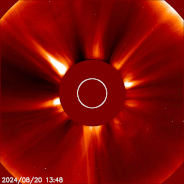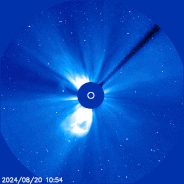../
about/
projects/sungrazer/
repository/
support/
contact/
The Sungrazer project is a NASA-funded citizen science project based and operated by the US Naval Research Laboratory, Washington DC. It uses images from space-based solar observatories, such as the Solar and Heliospheric Observatory [SOHO] and the Solar Dynamics Observatory [SDO], to find comets that are often too faint to be spotted with ground-based telescopes. These observatories capture images of the Sun and its surroundings, and citizen scientists analyze these images to spot potential comets.
Key aspects of the Sungrazer Project include:
Data Analysis: Volunteers sift through vast amounts of data to identify streaks and objects that could be comets. This involves looking at high-resolution images and time-lapse sequences provided by solar observatories.
Identification and Tracking: Once a potential sungrazing comet is identified, it is tracked and studied to determine its trajectory and characteristics. This information helps scientists understand the behavior of these comets and their interactions with the Sun.
Contribution to Science: By participating in the Sungrazer Project, citizen scientists contribute valuable data that enhances our understanding of sungrazing comets, their origins, and their potential impact on the solar environment.
The Sungrazer Project not only helps in the discovery of new comets but also engages the public in meaningful scientific research, highlighting the power of citizen science in expanding our knowledge of celestial phenomena.


[LASCO C2/C3 high-resolution images processed using open-source software]
LASCO C2/C3 images are a type of data produced by the Large Angle and Spectrometric Coronagraph [LASCO], which is an instrument aboard the SOHO spacecraft. LASCO is designed to observe the Sun’s outer atmosphere, or corona, by blocking out the Sun’s bright light, allowing fainter features such as the corona, solar wind, and objects like comets to be seen.
